stop start Lexus IS220d 2012 Workshop Manual
[x] Cancel search | Manufacturer: LEXUS, Model Year: 2012, Model line: IS220d, Model: Lexus IS220d 2012Pages: 609, PDF Size: 14.63 MB
Page 221 of 609
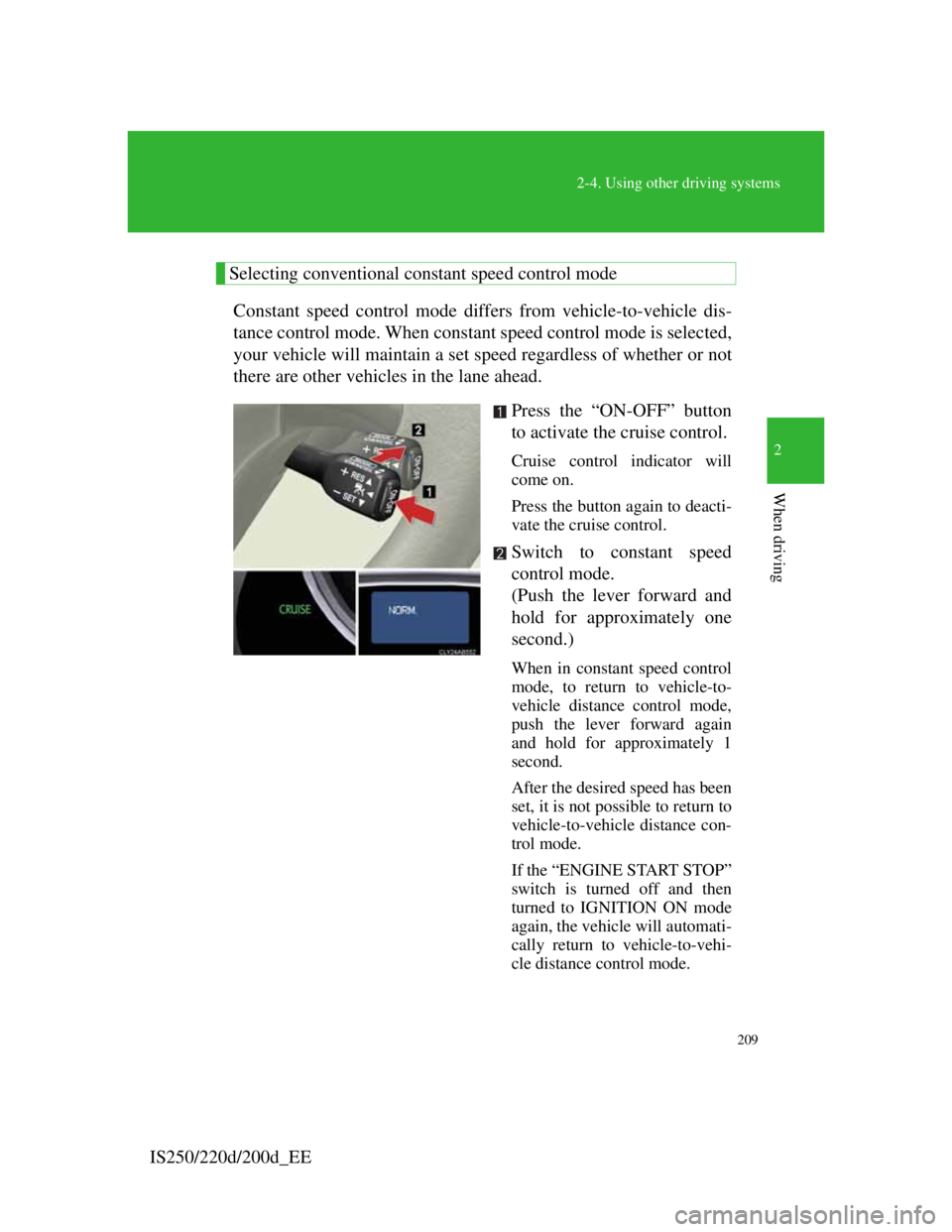
209
2-4. Using other driving systems
2
When driving
IS250/220d/200d_EE
Selecting conventional constant speed control mode
Constant speed control mode differs from vehicle-to-vehicle dis-
tance control mode. When constant speed control mode is selected,
your vehicle will maintain a set speed regardless of whether or not
there are other vehicles in the lane ahead.
Press the “ON-OFF” button
to activate the cruise control.
Cruise control indicator will
come on.
Press the button again to deacti-
vate the cruise control.
Switch to constant speed
control mode.
(Push the lever forward and
hold for approximately one
second.)
When in constant speed control
mode, to return to vehicle-to-
vehicle distance control mode,
push the lever forward again
and hold for approximately 1
second.
After the desired speed has been
set, it is not possible to return to
vehicle-to-vehicle distance con-
trol mode.
If the “ENGINE START STOP”
switch is turned off and then
turned to IGNITION ON mode
again, the vehicle will automati-
cally return to vehicle-to-vehi-
cle distance control mode.
Page 236 of 609
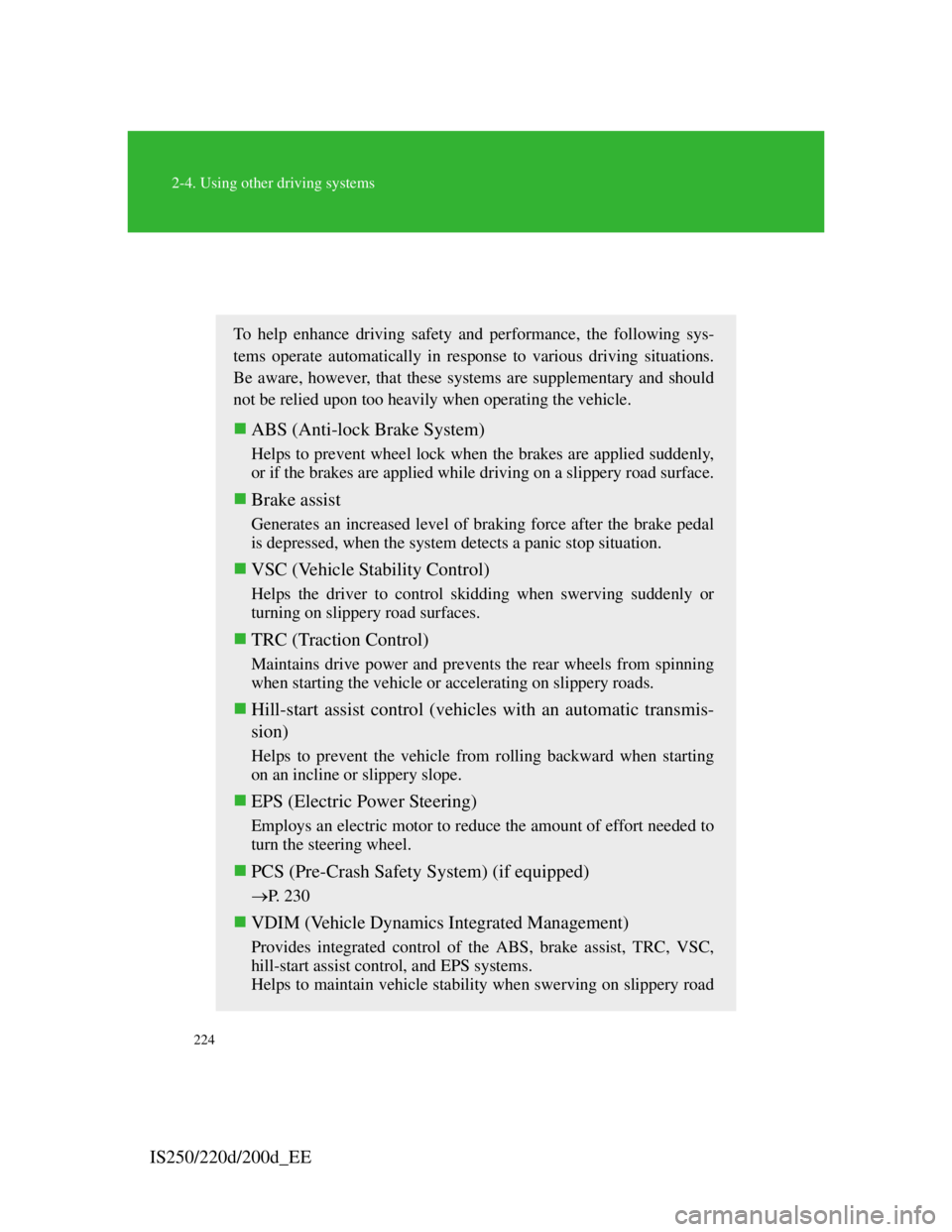
224
2-4. Using other driving systems
IS250/220d/200d_EE
Driving assist systems
To help enhance driving safety and performance, the following sys-
tems operate automatically in response to various driving situations.
Be aware, however, that these systems are supplementary and should
not be relied upon too heavily when operating the vehicle.
ABS (Anti-lock Brake System)
Helps to prevent wheel lock when the brakes are applied suddenly,
or if the brakes are applied while driving on a slippery road surface.
Brake assist
Generates an increased level of braking force after the brake pedal
is depressed, when the system detects a panic stop situation.
VSC (Vehicle Stability Control)
Helps the driver to control skidding when swerving suddenly or
turning on slippery road surfaces.
TRC (Traction Control)
Maintains drive power and prevents the rear wheels from spinning
when starting the vehicle or accelerating on slippery roads.
Hill-start assist control (vehicles with an automatic transmis-
sion)
Helps to prevent the vehicle from rolling backward when starting
on an incline or slippery slope.
EPS (Electric Power Steering)
Employs an electric motor to reduce the amount of effort needed to
turn the steering wheel.
PCS (Pre-Crash Safety System) (if equipped)
P. 230
VDIM (Vehicle Dynamics Integrated Management)
Provides integrated control of the ABS, brake assist, TRC, VSC,
hill-start assist control, and EPS systems.
Helps to maintain vehicle stability when swerving on slippery road
Page 237 of 609
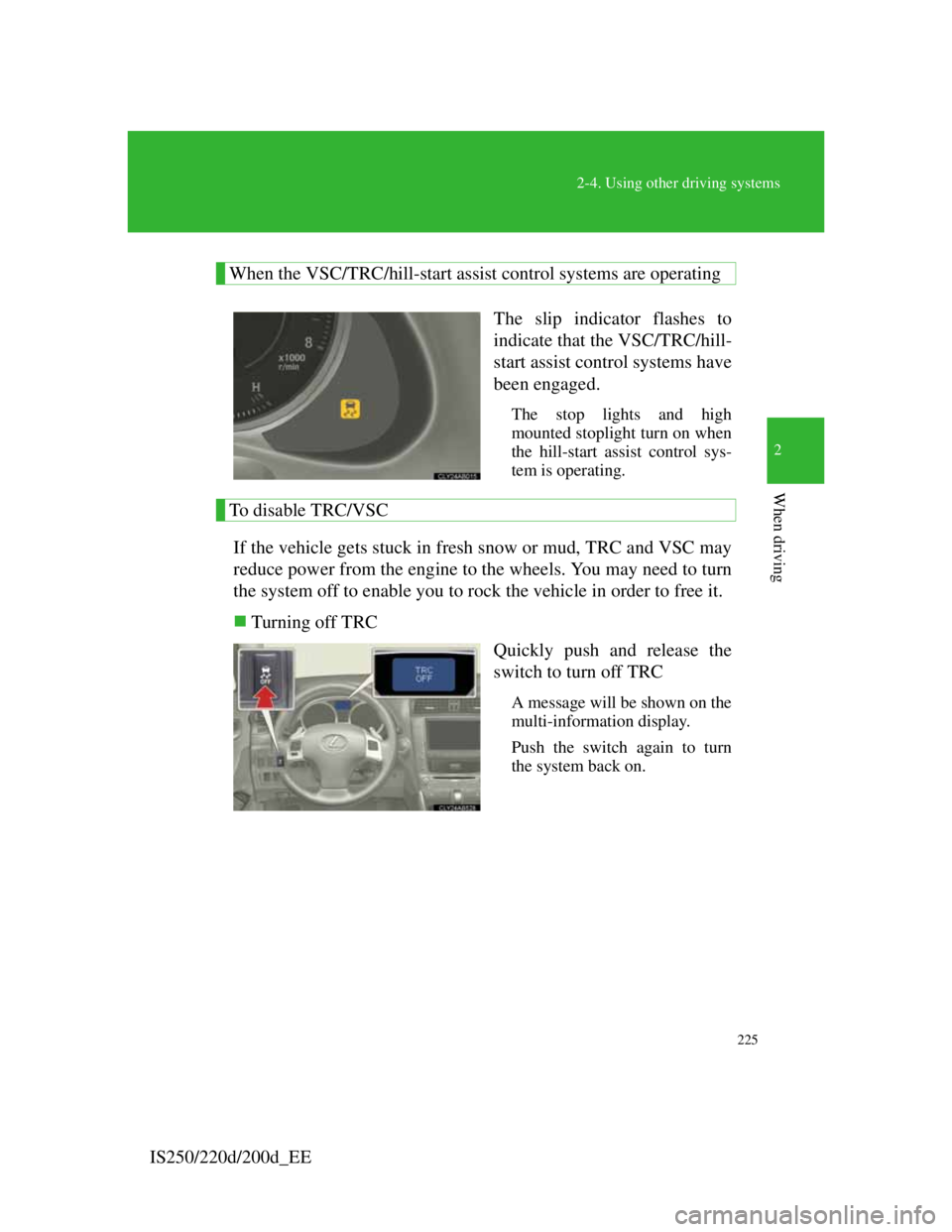
225
2-4. Using other driving systems
2
When driving
IS250/220d/200d_EE
When the VSC/TRC/hill-start assist control systems are operating
The slip indicator flashes to
indicate that the VSC/TRC/hill-
start assist control systems have
been engaged.
The stop lights and high
mounted stoplight turn on when
the hill-start assist control sys-
tem is operating.
To disable TRC/VSC
If the vehicle gets stuck in fresh snow or mud, TRC and VSC may
reduce power from the engine to the wheels. You may need to turn
the system off to enable you to rock the vehicle in order to free it.
Turning off TRC
Quickly push and release the
switch to turn off TRC
A message will be shown on the
multi-information display.
Push the switch again to turn
the system back on.
Page 238 of 609
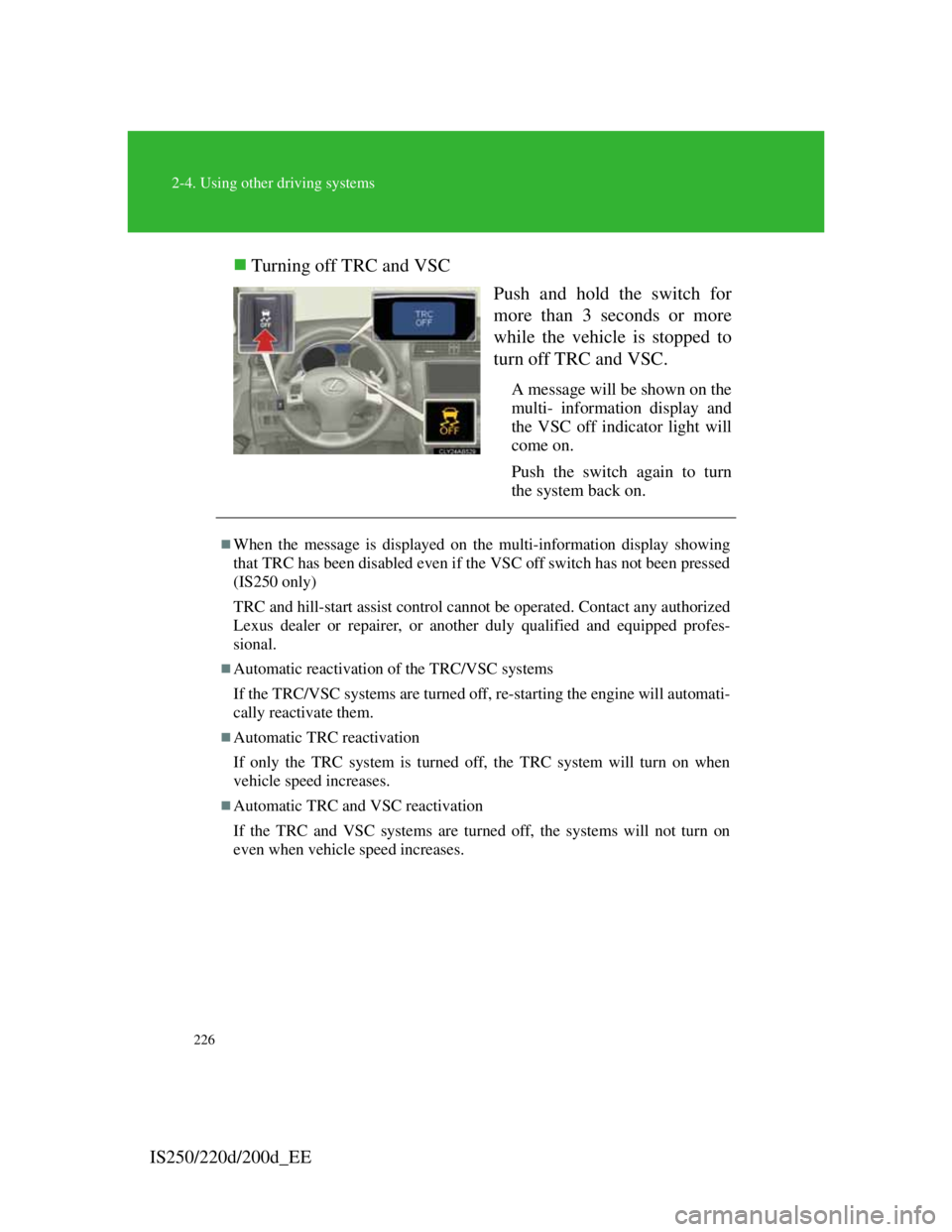
226
2-4. Using other driving systems
IS250/220d/200d_EETurning off TRC and VSC
Push and hold the switch for
more than 3 seconds or more
while the vehicle is stopped to
turn off TRC and VSC.
A message will be shown on the
multi- information display and
the VSC off indicator light will
come on.
Push the switch again to turn
the system back on.
When the message is displayed on the multi-information display showing
that TRC has been disabled even if the VSC off switch has not been pressed
(IS250 only)
TRC and hill-start assist control cannot be operated. Contact any authorized
Lexus dealer or repairer, or another duly qualified and equipped profes-
sional.
Automatic reactivation of the TRC/VSC systems
If the TRC/VSC systems are turned off, re-starting the engine will automati-
cally reactivate them.
Automatic TRC reactivation
If only the TRC system is turned off, the TRC system will turn on when
vehicle speed increases.
Automatic TRC and VSC reactivation
If the TRC and VSC systems are turned off, the systems will not turn on
even when vehicle speed increases.
Page 239 of 609

227
2-4. Using other driving systems
2
When driving
IS250/220d/200d_EE
Sounds and vibrations caused by the ABS, brake assist, VSC, TRC and hill-
start assist control systems
A sound may be heard from the engine compartment if the brake pedal is
depressed repeatedly when the engine is started or just after the vehicle
begins to move. This sound does not indicate that a malfunction has
occurred in any of these systems.
Any of the following conditions may occur when the above systems are
operating. None of these indicates that a malfunction has occurred.
• Vibrations may be felt through the vehicle body and steering.
• A motor sound may be heard after the vehicle comes to a stop.
• The brake pedal may pulsate slightly when the ABS is activated.
• The brake pedal may move down slightly after the ABS is activated.
Hill-start assist control is operational when
The shift lever is in the D or S position.
The brake pedal is not depressed.
The vehicle rolls backward.
EPS operation sound
When the steering wheel operates, a motor sound (whirring sound) may be
heard. This does not indicate a malfunction.
Reduced effectiveness of EPS
The effectiveness of EPS is reduced to prevent the system from overheating
when there is frequent steering input over an extended period of time. The
steering wheel may feel heavy as a result. Should this occur, refrain from
excessive steering input or stop the vehicle and turn the engine OFF. The
system should return to normal within 10 minutes.
If the slip indicator comes on
It may indicate a malfunction in the VSC, TRC or hill start assist control
function. Contact any authorized Lexus dealer or repairer, or another duly
qualified and equipped professional.
Page 240 of 609
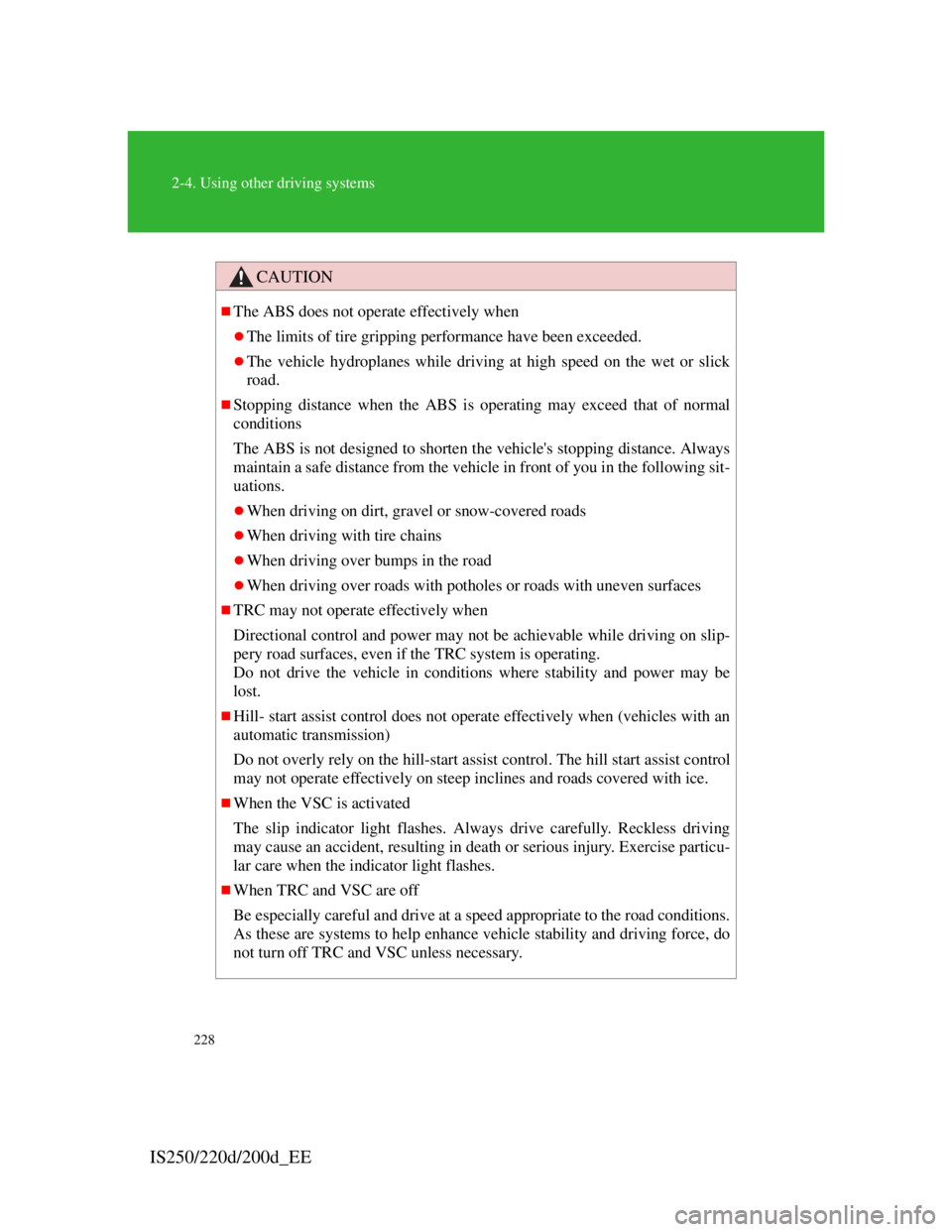
228
2-4. Using other driving systems
IS250/220d/200d_EE
CAUTION
The ABS does not operate effectively when
The limits of tire gripping performance have been exceeded.
The vehicle hydroplanes while driving at high speed on the wet or slick
road.
Stopping distance when the ABS is operating may exceed that of normal
conditions
The ABS is not designed to shorten the vehicle's stopping distance. Always
maintain a safe distance from the vehicle in front of you in the following sit-
uations.
When driving on dirt, gravel or snow-covered roads
When driving with tire chains
When driving over bumps in the road
When driving over roads with potholes or roads with uneven surfaces
TRC may not operate effectively when
Directional control and power may not be achievable while driving on slip-
pery road surfaces, even if the TRC system is operating.
Do not drive the vehicle in conditions where stability and power may be
lost.
Hill- start assist control does not operate effectively when (vehicles with an
automatic transmission)
Do not overly rely on the hill-start assist control. The hill start assist control
may not operate effectively on steep inclines and roads covered with ice.
When the VSC is activated
The slip indicator light flashes. Always drive carefully. Reckless driving
may cause an accident, resulting in death or serious injury. Exercise particu-
lar care when the indicator light flashes.
When TRC and VSC are off
Be especially careful and drive at a speed appropriate to the road conditions.
As these are systems to help enhance vehicle stability and driving force, do
not turn off TRC and VSC unless necessary.
Page 263 of 609

249
2-5. Driving information
2
When driving
IS250/220d/200d_EEImportant points regarding turning
The wheels of the trailer will travel closer to the inside of the
curve than the wheels of the vehicle. To make allowance for this,
take the turns wider than you would normally.
Important points regarding stability
Vehicle movement resulting from uneven road surfaces and
strong crosswinds will affect handling. The vehicle may also be
rocked by passing buses or large trucks. Frequently check
behind when moving alongside such vehicles. As soon as such
vehicle movement occurs, immediately start to decelerate
smoothly by slowly applying the brakes. Always steer the vehi-
cle straight ahead while braking.
Passing other vehicles
Consider the total combined length of your vehicle and trailer
and ensure that the vehicle-to-vehicle distance is sufficient
before executing lane changes.
Transmission information
Refrain from driving in 6 (manual transmission) or 4 range in S
mode (automatic transmission) to maintain the effectiveness of
the engine brake and the charge performance of electrical com-
ponents.
If the engine overheats...
Towing a loaded trailer up a long steep incline in temperatures
exceeding 30C (85F) may result in the engine overheating. If
the engine coolant temperature gauge indicates that the engine is
overheating, turn the air conditioning off immediately, leave the
road and stop the vehicle in a safe place. (P. 525)
When parking the vehicle
Always place wheel chocks under the wheels of both the vehicle
and trailer. Firmly set the parking brake and shift the shift lever
to P for automatic transmissions, and 1 or R for manual trans-
missions.
Page 276 of 609

262
3-1. Using the air conditioning system and defogger
IS250/220d/200d_EE
Automatic mode for air intake control (IS250 only)
In automatic mode, the system detects exhaust gas and other pollutants and
automatically switches between outside air and recirculated air modes.
Pollen removal mode
In order to prevent the windshield from fogging up when the outside air
is cold, the following may occur.
• Outside air mode does not switch to .
• The air conditioning system operates automatically.
• The operation cancels after 1 minute.
In rainy weather, the windows may fog up. Press .
Air conditioning odors
During use, various odors from inside and outside the vehicle may enter
into and accumulate in the air conditioning system. This may then cause
odor to be emitted from the vents.
To reduce potential odors from occurring:
• It is recommended that the air conditioning system be set to outside air
mode prior to turning the vehicle off.
• The start timing of the blower may be delayed for a short period of
time immediately after the air conditioning system is started in auto-
matic mode.
CAUTION
To prevent the windshield from fogging up
Do not use during cool air operation in extremely humid weather.
The difference between the temperature of the outside air and that of the
windshield can cause the outer surface of the windshield to fog up, blocking
your vision.
NOTICE
To prevent battery discharge
Do not leave the air conditioning system on longer than necessary when the
engine is stopped.
Page 279 of 609

265
3-1. Using the air conditioning system and defogger
3
Interior features
IS250/220d/200d_EE
Rear window and outside rear view mirror defoggers
The defogger can be operated when
The “ENGINE START STOP” switch is in IGNITION ON mode.
CAUTION
When the outside rear view mirror defoggers are on
Do not touch the outside surface of the rear view mirror, as it can become
very hot and burn you.
These features are used to defog the rear window, and to remove rain-
drops, dew and frost from the outside rear view mirrors.
With navigation system
Owners of models equipped with a navigation system should refer to
the “Navigation System Owner's Manual”.
Without navigation system
On/off
The defoggers will automati-
cally turn off after approxi-
mately 15 to 60 minutes.
Page 280 of 609

266
3-1. Using the air conditioning system and defogger
IS250/220d/200d_EE
Windshield wiper de-icer
The windshield wiper de-icer can be operated when
The “ENGINE START STOP” switch is in IGNITION ON mode.
CAUTION
When the windshield wiper de-icer is on
The surface of the glass at the lower part and sides of the windshield
become very hot. To prevent burning yourself, do not touch these areas.
: If equipped
This feature is used to prevent ice from building up on the windshield
and wiper blades.
On/off
The windshield wiper de-icer
will automatically turn off
after approximately 15 min-
utes.